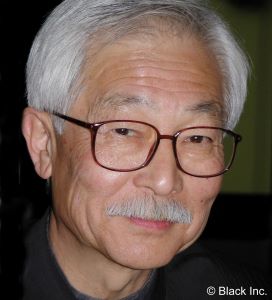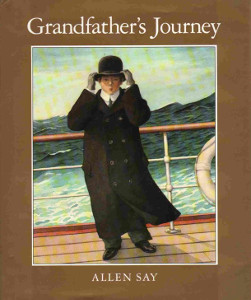Allen Say ![]()
The Resilient Cartoonist: The Story of Allen Say
Allen Say was born on August 28, 1937, in Japan. By today’s standards, if there was ever an artist that had every reason to paint darkness and chaos filled with bitterness and anger, it was Allen Say. Allen was born in an era of Japanese nationalism to a Korean father and Japanese mother, whose family was disappointed their daughter hadn’t married someone of Japanese descent. This racism coupled with the nationalistic fervor of the age created serious issues for Allen when he declared to his family that he was going to grow up to be an artist, specifically a cartoonist. Both Allen’s grandmother and his father thought this was a profession that would not bring honor to their family.
Allen believed that the second World War not only destroyed his country, it also destroyed his family. His father left his mother to start a new family, and his mother sent him to live with his grandmother in Tokyo. It was not long till Allen’s grandmother told him she thought it would be best if he went to live on his own, Allen was twelve years old! By the time Allen was thirteen, he was living on his own in the vast city of post-war Tokyo, but Allen had drive, determination, and a passion for art. On his first day living on his own he sat down with food in a restaurant and a copy of the local newspaper, and there featured in the paper along with his home address, was Allen’s cartoonist idol. Allen took the paper, walked to the expert cartoonist’s house, and presented himself as his newest apprentice. Allen was accepted and spent the next several years working under this expert artist. Allen and his “sensei” had a tight bond, and Allen would later call him his “spiritual father.” Allen’s sensei, Noro Shenpei, even turned Allen into one of Japan’s most beloved cartoon characters, Kyusuke. Years later when a news reporter asked Noro Shenpei what it was like when Allen Say showed up demanding to be his apprentice, Shenpei said of Allen, “He came to me as a man wearing the mask of a boy.”
When Allen was fifteen, he unexpectedly received a check in the mail from his father along with a letter. Allen’s father had never supported Allen financially and rarely reached out to him at all, so the letter came as a shock, and Allen was immediately suspicious. As he read the letter, he was stunned to read that his father planned on immigrating to the United States and wanted Allen to join him. Allen did not know what to do, but at the advice of his mother, friends, and sensei, he decided to go on a grand adventure to the United States. When he left Japan, Allen was fifteen, and it was 1953.
Allen arrived in California with his father, his father’s new wife, and their baby girl to find that his father had committed him to attending a military academy, where he would also work to afford his tuition. Allen’s father’s parting words accompanied by a single ten-dollar bill were, “Don’t disgrace me in America.” At the camp, Allen faced one challenge after another, and the battle that waged in his head as he was required to work at mind-numbing menial drudgery after years of freedom of living on his own, is a true triumph of mental toughness and positivity. As he mopped floors he told himself, “Life’s an adventure”, and as he painted fences, “Imagine you are painting a mural all in one color”. The words of his old sensei rang in his ears, and when all he could see to draw around him were the bathrooms and urinals he cleaned, that is what he sketched! And in the triumph of his mind, they all turned into cartoons! Even when at the complaint of a fellow student whose father had served in Japan during World War 2, Allen was moved from the dorms with the other students to stay in the property shed with old mattresses, black widows, and poisonous bug killer, Allen found that the angrier he got the funnier his cartoon drawings became. Eventually, the racist complaints lead the school’s owner to send a message to Allen’s father stating he didn’t think Allen would make a “wholesome American” and that he had one week to find a new place to live. The camp owner thought Allen’s father would take him back in; he did not.
Obviously in winning a Caldecott Award for his book Grandfather’s Journey artist Allen Say triumphed over adversity, but it wasn’t until he was 35 years old that he had his first book, Dr. Smith’s Safari, published. Of the over thirty books Allen Say either wrote and illustrated or illustrated for others, one gathers the overwhelming sense that Allen fought hard and won the battle to dwell in the adventure, humor, and beauty of what was certainly a very challenging existence. Reading his graphic novel, fictionalized autobiographies and hearing him talk in interviews about his life and work are incredible lessons in joyful resilience. Our feature of him as the illustrator of the month is a celebration of his triumphal tenacity to all things good, true, and beautiful.
—Lara McConnell Lleverino





